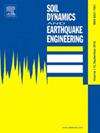Seismic design of a low-carbon building constructed with in-situ produced compressed earth blocks
IF 4.2
2区 工程技术
Q1 ENGINEERING, GEOLOGICAL
引用次数: 0
Abstract
The seismic design of buildings erected using new low-carbon construction materials needs the development of a reliable methodology. In this research, a pilot project of a compressed earth block (CEB) masonry building in a medium-high seismic hazard zone in Southern France is developed. The CEBs are produced in-situ, using a machine, and are used as construction material for low-rise masonry buildings. This innovative low-carbon construction technology permits the reuse of local soil, removed during earthworks, with consequent reduction of energy consumption related to its collection, transport, recovery, and disposal. Even if the CEB masonry building is a promising low-carbon construction, its structural performance assessment, especially in seismic zones, is a challenging issue.
Starting from the experimental characterization of material mechanical parameters, the seismic design approach focuses on the modal characteristics of the structure, the expected building ductility, and seismic performance assessment in terms of both displacement and force. The behavior factor for a CEB masonry building is an original result of this research. The equivalent frame model adopted for structural design of load-bearing masonry is validated, after the building construction, by comparing the dynamic properties obtained by both numerical and operational modal analysis. Moreover, the modal analysis highlights the impact of the timber slab stiffness on the dynamic response of masonry buildings and suggests that a careful timber slab conception improves the structural behavior under seismic loading.
用就地生产的压缩土块建造低碳建筑的抗震设计
对使用新型低碳建筑材料建造的建筑物进行抗震设计需要开发一种可靠的方法。在这项研究中,开发了一个在法国南部中高地震危险区建造压缩土块(CEB)砌体建筑的试点项目。压缩土砌块使用机器就地生产,用作低层砌体建筑的建筑材料。这种创新的低碳建筑技术可以重新利用土方工程中移除的当地土壤,从而减少与土壤收集、运输、回收和处理相关的能源消耗。尽管 CEB 砌体建筑是一种前景广阔的低碳建筑,但其结构性能评估,尤其是在地震带上的结构性能评估,却是一个具有挑战性的问题。从材料力学参数的实验表征开始,抗震设计方法侧重于结构的模态特征、预期的建筑延性以及位移和力方面的抗震性能评估。CEB 砌体建筑的行为系数是这项研究的原创性成果。建筑物建成后,通过比较数值分析和运行模态分析获得的动态特性,验证了用于承重砌体结构设计的等效框架模型。此外,模态分析凸显了木板刚度对砌体建筑动态响应的影响,并表明精心的木板构思可改善地震荷载下的结构行为。
本文章由计算机程序翻译,如有差异,请以英文原文为准。
求助全文
约1分钟内获得全文
求助全文
来源期刊

Soil Dynamics and Earthquake Engineering
工程技术-地球科学综合
CiteScore
7.50
自引率
15.00%
发文量
446
审稿时长
8 months
期刊介绍:
The journal aims to encourage and enhance the role of mechanics and other disciplines as they relate to earthquake engineering by providing opportunities for the publication of the work of applied mathematicians, engineers and other applied scientists involved in solving problems closely related to the field of earthquake engineering and geotechnical earthquake engineering.
Emphasis is placed on new concepts and techniques, but case histories will also be published if they enhance the presentation and understanding of new technical concepts.
 求助内容:
求助内容: 应助结果提醒方式:
应助结果提醒方式:


